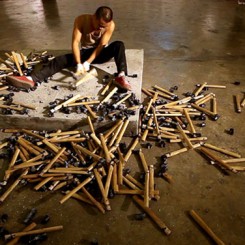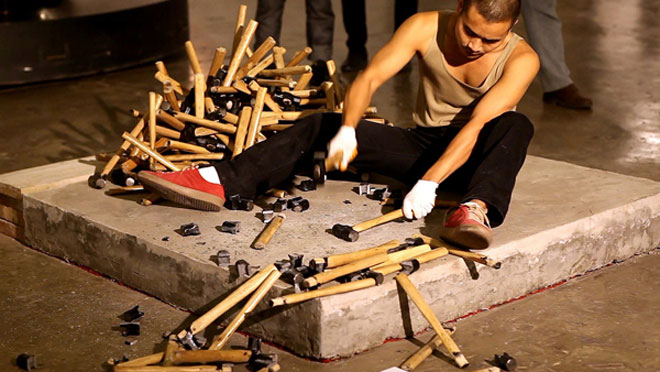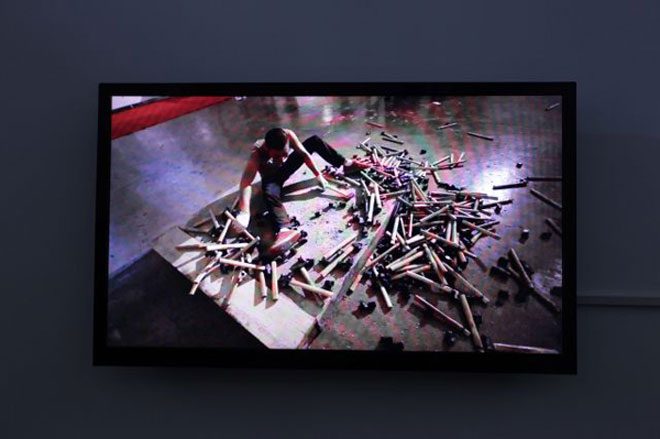“YELLOW.ANTS.ART.LAB project#2: The Borrowing of Art”, Hu Qingtai Solo Exhibition, Mar 30 – Apr 4, 2013.
“YELLOW.ANTS.ART.LAB project#1: Spring in the Sewer“, Li Binyuan Solo Exhibition, Mar 9 – 24, 2013.
“FRONT.ROOM.LOOP project#1: Deathless Love“, Li Binyuan Solo Exhibition, Mar 9 – 24, 2013.
“Zhenxue ZHANG:No Position“,Zhenxue ZHANG Solo Exhibition, Mar 9 – 24, 2013.
Gallery 55(Room 112, Building 4A, 50 Moganshan Road, Shanghai)
______________________
This year, Gallery 55 has established a series of independent projects: the YELLOW.ANTS.ART.LAB. In light of this, randian editor Gu Ling interviewed the director of the gallery, Ferdie Ju, to learn more.
Gu Ling: Gallery 55 is a gallery, so why set up a “non-profit” space?
Ferdie Ju: “Non-profit” is a relative concept. The YELLOW.ANTS.ART.LAB has a primarily non-commercial goal, but this doesn’t mean that it will go against the operating principles of a gallery — if someone wants to buy art, we won’t say no. Rather, this means that the works within the project series may very well not sell at all. As an experimental space, YELLOW.ANTS aims at systematically bringing out focused, experimental proposals in order to provide a battleground for artists to organize the main thread of their artistic creation, and to offer a chance for them expose their work on the international contemporary art stage.
GL: Gallery 55 itself was founded on the basis that it would focus on young artists. So what’s the difference in how this new experimental space will operate vis-à-vis the main gallery space?
FJ: Gallery 55 was first founded in Bangkok, Thailand in 1999. It was run more like a creative center: not only were there only people from contemporary art scene but also from the worlds of design, fashion, music, performance, with interdisciplinary shows and exchanges. In 2005, we returned to China along with the rising tides and established a gallery within the Moganshan art district in Shanghai.
We have always focused primarily on young artists (artists from the 1970s and later), and have discovered and nurtured a good number of emerging artists. Actually, back in 2008, I already had the idea of starting up a purely experimental space. Later, I’d heard that Taikang Space in Beijing had organized the “51 sqm” series on completely non-profit principles, and that got me thinking — and I was to a certain degree encouraged by them. So I kept thinking and finally thought of cutting out a third of the gallery’s space to be dedicated to showing these independent experimental projects — and this would limit the burden for the gallery itself. Finally, we have realized this project this year.
Li Binyuan, “Deathless Love” , Performance on Video, 9’32”, 55 Project Space.
Li Binyuan, “Spring in the Sewer” , Installation Photo, 55 Project Space.
GL: So how does Gallery 55 choose the artists then?
FJ: First of all, there’s an age limit. The experimental space only invites artists born after 1980 — because in my eight years of experience, there’s a large gap every year, and with the younger generation, especially artists born after 1980, you see an incredible dynamism in their creation. As a gallery, we can use the openness of the experimental space and discover some emerging young artists and give them the chance to show their works to people within the art world, including critics, collectors, museums personnel and so forth. Additionally, there are of course requirements in terms of the quality of the works; I personally choose and contact the artists myself. And the artists are all very enthusiastic and willing to come when they get invited, and they cherish the chance to show in this project.
GL: Does Gallery 55 take on the production fees for this series completely?
FJ: No, we follow the Western model. Artists pay on their own in order to create; the gallery takes care of their room and board and travel expenses. I think creating work is the job of the artists; what the gallery can provide is the space, the platform, as well as the promotion and logistics. In my opinion, many organizations within the art world don’t focus on what they are good at and this leads to more confusion. Galleries want to be like museums and do stuff like public education, as though this would make them look better and more sophisticated, while museums want to earn money and sell art like galleries — this is all upside-down. In terms of the art system, I still very much agree with the mature art system of the West, where each part has its own specialty. Galleries are commercial and exhibition spaces; we do not have enough academic and financial resources. However, galleries discover and nurture first-rate artists; galleries are where artists begin their professional careers and where they get promoted. The development of contemporary art in China hasn’t reached a point where a new path should be blazed — when we’ve better grasped the more mature art system in the West,it won’t be too late to innovate then.
GL: You mentioned that galleries play the role of discovering and nurturing artists. But doesn’t the experimental project itself have limitations in terms of the space and presentation?
FJ: The space isn’t very big, and we haven’t specially invited curators. But I believe that young artists have no particular need to aim for large works — no need to mimic older artists in creating large-scale installations. As for curators, I think young artists can start from the basis of their own work. There’s no particular need to invite curators to define their works. I think it’s really important to grant creative freedom to artists; this is how they can produce artwork with a sense of uniqueness.
GL: And maybe there’s also a limitation of time? The experimental projects are shown at a very rapid rate, with a new show every month? How will the gallery maintain the quality?
FJ: Each individual project lasts three weeks, followed by a week of installation before the new show. In my personal experience, looking at the same work for four weeks gets a bit boring. This rate of new shows every month gives off a sense of dynamism to the media and to the art world, kind of like a constant parade of works. Every month there’re new works, new projects, new artists. Of course, we put in a lot of effort in the installation as well as in the budgeting, trying to satisfy the artists’ needs as much as possible — in fact, this project with Li Binyuan went over budget.
GL: Then what is the difference between the artists who participate in the experimental space vs the artists in the main space — in terms of the form of cooperation with the gallery?
FJ: The artists in the experimental space cooperate with the gallery on a one-off basis, since they are independent projects. So the gallery will not make the artists sign contracts, and in fact the artists could very well have another gallery representing them. This relatively more open style also guarantees that a greater variety of artists will be included in this series of projects. For instance, the next two artists come from Beijing: one will be realizing the ideas through purely archival material, without actual objects, while the other will be doing a multi-media installation.
GL: As the director of the gallery and the founder of this project series, what are your expectations for this series of experimental projects? And for the gallery?
FJ: Currently, in terms of the gallery, we are only 70-80% there, certainly not 100%, which is not very practical at any rate. Still, we will try hard. As for the experimental space, this is the first year, and I hope that we will get up to the full year with monthly additions. In actual fact, the project planning is almost complete, and the next round is for the next year. There may be some adjustments, rounding out the experience from this year. But there is also a practical problem: like all organizations, I can’t keep on at this myself, so one problem I will have to face sooner or later would be how to find someone who can continue on growing and pushing ahead with the gallery and with the experimental space.
Li Binyuan, “Deathless Love” , Installation Photo, 55 Project Space.
Zhenxue ZHANG, “No Position” , Installation Photo, 55 Project Space.
Zhenxue ZHANG, “No Position” , Installation Photo, 55 Project Space.








